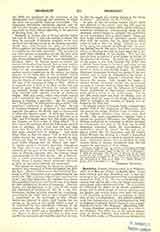

Beardsley, AUBREY, English artist, b. at Brighton, 1872; d. at Mentone, France, March 16, 1898. It has been cleverly said that Beardsley was “a boy who never grew up”, and the statement has a considerable amount of truth in it. He was a wonderfully precocious boy all his life, with the frank merriment, enthusiasm, and exuberance of a lad. He was unable to withstand the desire to do clever, mischievous things and to shock people of narrow opinions, and his ignoble and vicious works were more the result of his Puck-like mischief and eccentricity of habit than of any evil disposition. His earliest published work was a program for an entertainment in 1888 at Brighton Grammar School, where he was a pupil, and his next in the “Bee Magazine”, Blackburn, 1891.
Young Beardsley commenced work as a clerk in the Guardian Fire Office, but at the earnest persuasions of Aymer Valiance and Pennell he entered Fred Brown’s studio at Westminster and devoted his attention to illustration. While still a lad he attracted the attention of Sir E. Burne-Jones and Puvis de Chavannes, and it said much for his genius that it received encouragement from men so different in their aims and practice. When nineteen he accepted the tremendous task of illustrating the “Morte D’Arthur”, and carried it through. The famous article upon him in the “Studio” appeared in April, 1893, and from that moment his work was in great demand. In April, 1894, he became art editor of the “Yellow Book”, the first numbers of which caused a great sensation. He was responsible for the first four volumes and then, with Arthur Symons, started the “Savoy“, to which he contributed a series of drawings. During his short life he carried the art of black and white further than any man since Albrecht Dürer. His special qualities were described by Hammerton as of “extreme economy of means the perfection of discipline, of self-control, and of thoughtful deliberation at the very moment of invention”.
Beardsley had a marvellous knowledge of the quality of line, a real and powerful sense of beauty, coupled with a constant desire to be quaint, fanciful, or bizarre. He possessed a vigour, inventiveness, and daintiness almost unapproachable in the work of any other man. Hammerton speaks of the “serene surety of his drawing”, of his “superb sense of style”; but Beardsley’s love of mischief, which he deeply regretted, led him into serious faults and caused him to be often misunderstood. By those who knew him he was regarded as the most original, brilliant, witty, and lovable man they ever met. His illustrations of “Salome“, “The Rape of the Lock”, “Mademoiselle de Maupin” and “Volpone” are amongst his greatest works. From boyhood he had bad health and suffered from frequent attacks of haemorrhage. He was always a man of deep religious feeling and became a Catholic at the close of his life (March 31, 1895).
GEORGE CHARLES WILLIAMSON

